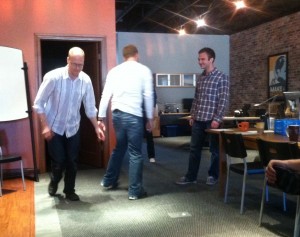We believe everything is better when communication flows freely and honestly. Transparency and sharing are critical to creating an effective work environment. This includes all interaction and communication among our employees, with our clients,
and with our partners.
In a recent team Huddle, we focused on our
Core Value #3 – Open and Honest. We engaged in a couple of entertaining, and telling,
group exercises to demonstrate the value of effective communication.

The first exercise was “Catching the Chicken.” It goes like this:
1. Ask for four volunteers from your group.
2. While three of the volunteers step out of the room, ask the rest of the group to sit in a circle.
3. Ask the remaining volunteer to step into the circle and imitate the action of catching a chicken in a barn.
4. The volunteer can only use actions to do this, and neither she nor the observers can speak throughout the exercise. Inform her
that the other volunteers will be entering to help in the task of “catching the chicken.”
5. Summon the other volunteers into the room, one-by-one, at intervals of around one minute. When you send them in, ask each of them to join their colleague in whatever they find her doing and help her out.
6. After all three volunteers have participated, end the game.
7. Ask each volunteer what they thought they were doing.
8. Typically, you’ll get some pretty funny (and wrong) answers.
9. Finally, ask the first volunteer to reveal what she was actually doing.
So, what did we learn while debriefing after this exercise? First off, we learned
Chad has evidently done his share of chicken-chasing, as he guessed
the answer immediately.
Secondly, although those starting out in the room were told not to speak, the volunteers who left the room were given no such instruction. Still, they jumped right in to “help” without asking any questions
or making any clarifications.
The lessons: How often is it that we jump into motion without clarifying what really needs to be done? Are we more likely to do this when the person giving us a directive is a leader or authority figure
(or a client)?
Our second exercise engaged both our communication and our artistic skills:
1. Select 3 simple line drawings to use during the exercise.
2. All participants are given 3 sheets of paper and a drawing utensil .
3. The organizer asks for a volunteer—this volunteer is given a copy of one of the line drawings,
but the drawing is kept secret from the rest of the group.
4. The volunteer then has a set amount of time to describe the drawing to the group—participants do their best to recreate the drawing without asking any questions.
5. The exercise is repeated two more times, with new volunteers and new drawings, with slightly new rules:
a. The participants may ask questions with yes/no answers .
b. The participants may ask open-ended questions.
We then followed with a discussion on the importance of a two-way flow of information, as well as clarification in communication. Several
brought up how verbal communication on its own can be difficult for some to interpret—that seeing something visually or in writing can be much more effective in some cases.
Do you take the time to clarify and communicate goals and details before leaping into action? Do you ask the right kinds of questions to get your hands on the information you need to be successful?
We’d love to
hear your thoughts on open and honest communication, as well as any suggestions you have for building this skill within a team.